engine Acura ZDX 2012 Owner's Manual
[x] Cancel search | Manufacturer: ACURA, Model Year: 2012, Model line: ZDX, Model: Acura ZDX 2012Pages: 645, PDF Size: 16.36 MB
Page 484 of 645

You must also press the release
button to shift into Park. To avoid
transmission damage, come to a
complete stop before shifting into
Park.On models without keyless accesssystemThe shift lever must be in Park
before you can remove the key from
the ignition switch.On models with keyless access
systemThe shift lever must be in Park
before you change the power mode
from ON to VEHICLE OFF (LOCK). Reverse (R)
-Press the brake
pedal and press the release button on
the front of the shift lever to shift
from Park to reverse. To shift from
reverse to neutral, come to a
complete stop, and then shift. Press
the release button before shifting
into reverse from neutral.
Neutral (N) -Use neutral if you
need to restart a stalled engine, or if
it is necessary to stop briefly with the
engine idling. Shift to the Park
position if you need to leave your
vehicle for any reason. Press on the
brake pedal when you are moving
the shift lever from neutral to
another gear. Drive (D)
-Use this position for
your normal driving. The
transmission automatically selects a
suitable gear (1 through 6) for your
speed and acceleration. You may
notice the transmission shifting up at
higher engine speeds when the
engine is cold. This helps the engine
warm up faster.
CONTINUED
Automatic Transmission
479
Driving
09/10/28 17:15:37 10 ACURA ZDX KA KC New North America Own 50 31SZN600 enu
Page 485 of 645

S position (S)-To shift into the S
position, press the release button on
the front of the shift lever, and move
the lever to S. This position is similar
to D, except only gears from first to
fifth are selected. (When shifting up
automatically, the vehicle speed is
higher than when in the D position.)
The S position keeps the
transmission from cycling between
fourth, fifth, and sixth gears in stop-
and-go driving.
With the shift lever in D or S, you
can also use the paddle shifters to
shift the transmission up or down.
With the paddle shifters, you can
operate the transmission much like a
manual transmission without a clutch
pedal. For more information on
driving with the paddle shifters, see
page 482. Engine Speed Limiter
If you exceed the maximum speed
for the gear you are in, the engine
speed will enter into the
tachometer's red zone. If this occurs,
you may feel the engine cut in and
out. This is caused by a limiter in the
engine's computer controls. The
engine will run normally when you
reduce the rpm below the red zone.
The engine may cut in and out in R
position or depending on the road
condition, even when the engine
speed is lower than the tachometer's
red zone. This is the engine's
computer working to protect the
transmission.
Shift Lock Release
This allows you to move the shift
lever out of Park if the normal
method of pushing on the brake
pedal and pressing the release button
does not work.
1. Set the parking brake.
2.
On models without keyless access
systemRemove the key from the ignition
switch.On models with keyless accesssystemRemove the built-in key from the
keyless access remote (see page
207).
Automatic Transmission48009/10/28 17:15:37 10 ACURA ZDX KA KC New North America Own 50 31SZN600 enu
Page 486 of 645
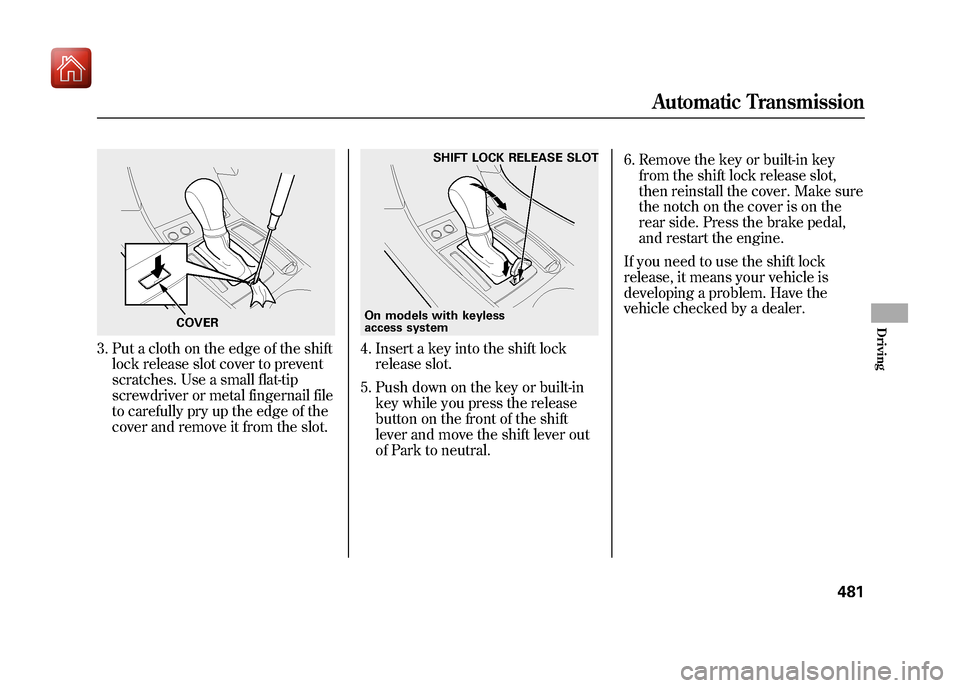
3. Put a cloth on the edge of the shiftlock release slot cover to prevent
scratches. Use a small flat-tip
screwdriver or metal fingernail file
to carefully pry up the edge of the
cover and remove it from the slot.
4. Insert a key into the shift lockrelease slot.
5. Push down on the key or built-in key while you press the release
button on the front of the shift
lever and move the shift lever out
of Park to neutral. 6. Remove the key or built-in key
from the shift lock release slot,
then reinstall the cover. Make sure
the notch on the cover is on the
rear side. Press the brake pedal,
and restart the engine.
If you need to use the shift lock
release, it means your vehicle is
developing a problem. Have the
vehicle checked by a dealer.
COVER
SHIFT LOCK RELEASE SLOT
On models with keyless
access system
Automatic Transmission
481
Driving
09/10/28 17:15:37 10 ACURA ZDX KA KC New North America Own 50 31SZN600 enu
Page 487 of 645
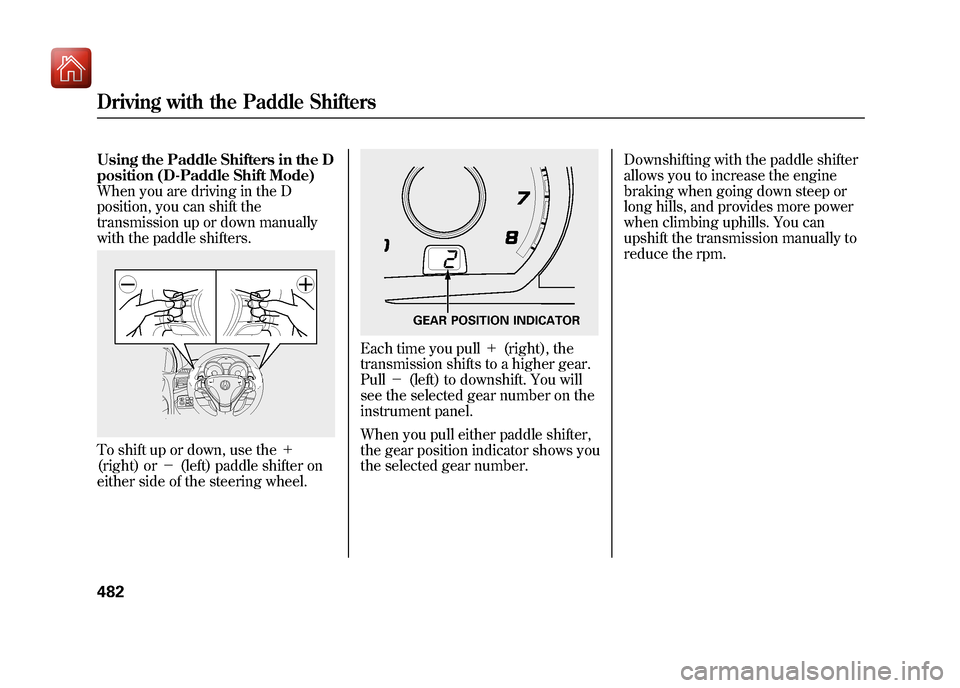
Using the Paddle Shifters in the D
position (D-Paddle Shift Mode)
When you are driving in the D
position, you can shift the
transmission up or down manually
with the paddle shifters.To shift up or down, use the+
(right) or -(left) paddle shifter on
either side of the steering wheel.
Each time you pull +(right), the
transmission shifts to a higher gear.
Pull -(left) to downshift. You will
see the selected gear number on the
instrument panel.
When you pull either paddle shifter,
the gear position indicator shows you
the selected gear number. Downshifting with the paddle shifter
allows you to increase the engine
braking when going down steep or
long hills, and provides more power
when climbing uphills. You can
upshift the transmission manually to
reduce the rpm.
GEAR POSITION INDICATOR
Driving with the Paddle Shifters48209/10/28 17:15:37 10 ACURA ZDX KA KC New North America Own 50 31SZN600 enu
Page 488 of 645
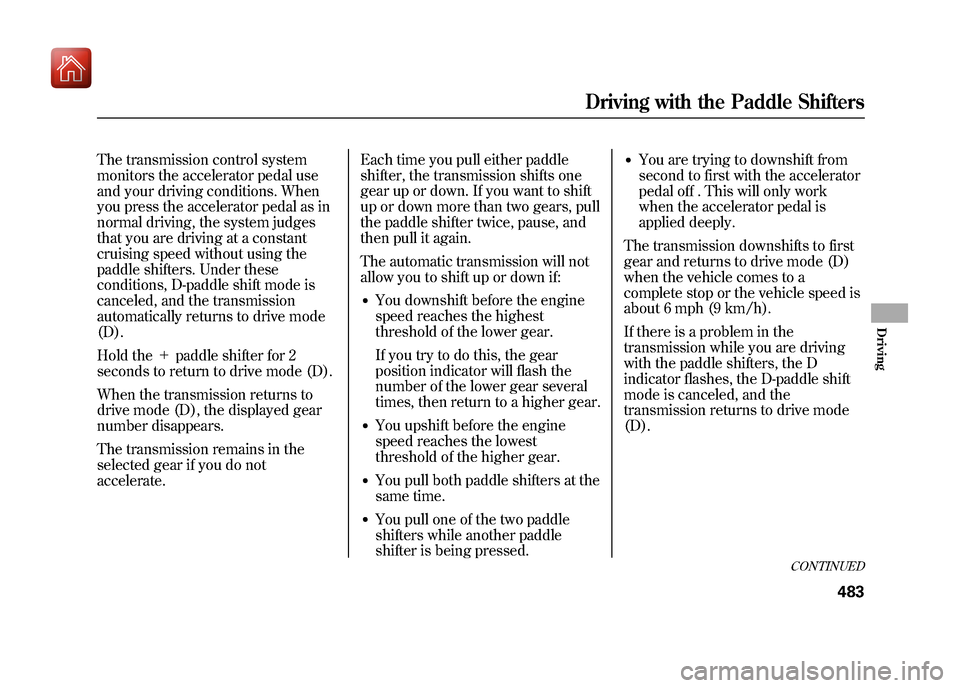
The transmission control system
monitors the accelerator pedal use
and your driving conditions. When
you press the accelerator pedal as in
normal driving, the system judges
that you are driving at a constant
cruising speed without using the
paddle shifters. Under these
conditions, D-paddle shift mode is
canceled, and the transmission
automatically returns to drive mode
(D).
Hold the+paddle shifter for 2
seconds to return to drive mode (D).
When the transmission returns to
drive mode (D), the displayed gear
number disappears.
The transmission remains in the
selected gear if you do not
accelerate. Each time you pull either paddle
shifter, the transmission shifts one
gear up or down. If you want to shift
up or down more than two gears, pull
the paddle shifter twice, pause, and
then pull it again.
The automatic transmission will not
allow you to shift up or down if:
●You downshift before the engine
speed reaches the highest
threshold of the lower gear.
If you try to do this, the gear
position indicator will flash the
number of the lower gear several
times, then return to a higher gear.●You upshift before the engine
speed reaches the lowest
threshold of the higher gear.●You pull both paddle shifters at the
same time.●You pull one of the two paddle
shifters while another paddle
shifter is being pressed.
●You are trying to downshift from
second to first with the accelerator
pedal off . This will only work
when the accelerator pedal is
applied deeply.
The transmission downshifts to first
gear and returns to drive mode (D)
when the vehicle comes to a
complete stop or the vehicle speed is
about 6 mph (9 km/h).
If there is a problem in the
transmission while you are driving
with the paddle shifters, the D
indicator flashes, the D-paddle shift
mode is canceled, and the
transmission returns to drive mode
(D).
CONTINUED
Driving with the Paddle Shifters
483
Driving
09/10/28 17:15:37 10 ACURA ZDX KA KC New North America Own 50 31SZN600 enu
Page 490 of 645

When you accelerate from a stop, the
transmission starts in first gear, and
shifts from first to second
automatically.You must manually
upshift between second and fifth
gears. Make sure you upshift before
the engine speed reaches the
tachometer's red zone.The transmission remains in the
selected gear (6, 5, 4, 3, or 2). There
is no automatic downshift when you
push the accelerator pedal to the
floor.
When you are driving, the
transmission downshifts to the lower
gear under the following conditions:
●The vehicle slows down to a
certain speed.●You press the brake pedal.●The vehicle detects that you are
driving uphill or downhill.Downshifting with the paddle shifter
allows you to increase the engine
braking when going down steep or
long hills, and provides more power
when climbing uphills. You can
upshift the transmission manually to
reduce the rpm.
The transmission also shifts
automatically as the vehicle comes to
a complete stop. It downshifts to first
gear when the vehicle speed reaches
6 mph (9 km/h) or less.
CONTINUED
Driving with the Paddle Shifters
485
Driving
09/10/28 17:15:37 10 ACURA ZDX KA KC New North America Own 50 31SZN600 enu
Page 491 of 645
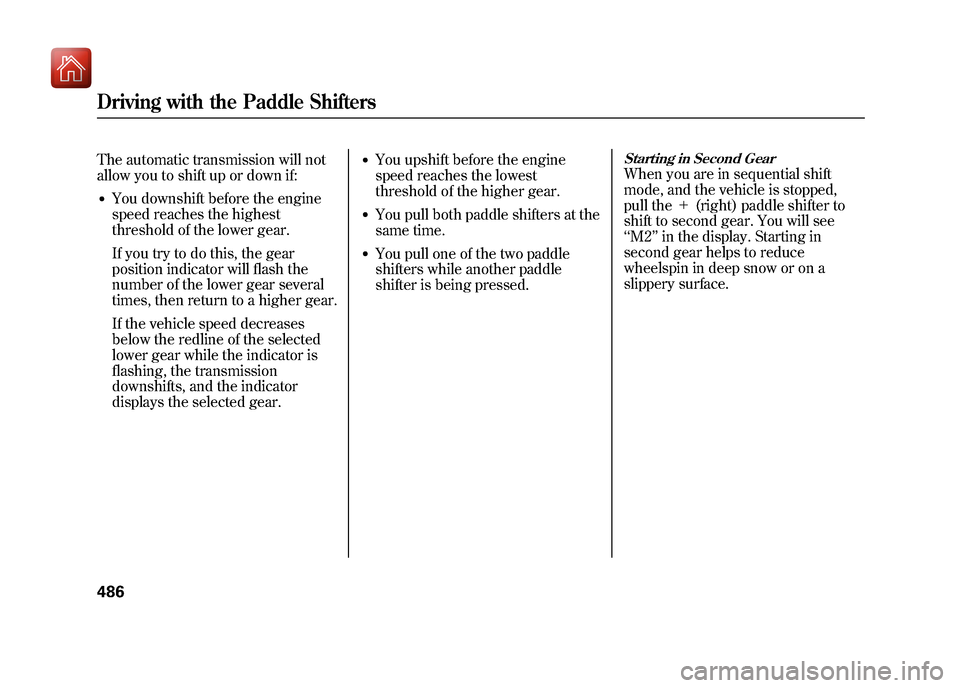
The automatic transmission will not
allow you to shift up or down if:●You downshift before the engine
speed reaches the highest
threshold of the lower gear.
If you try to do this, the gear
position indicator will flash the
number of the lower gear several
times, then return to a higher gear.
If the vehicle speed decreases
below the redline of the selected
lower gear while the indicator is
flashing, the transmission
downshifts, and the indicator
displays the selected gear.
●You upshift before the engine
speed reaches the lowest
threshold of the higher gear.●You pull both paddle shifters at the
same time.●You pull one of the two paddle
shifters while another paddle
shifter is being pressed.
Starting in Second GearWhen you are in sequential shift
mode, and the vehicle is stopped,
pull the+(right) paddle shifter to
shift to second gear. You will see
‘‘ M2’’ in the display. Starting in
second gear helps to reduce
wheelspin in deep snow or on a
slippery surface.
Driving with the Paddle Shifters48609/10/28 17:15:37 10 ACURA ZDX KA KC New North America Own 50 31SZN600 enu
Page 492 of 645
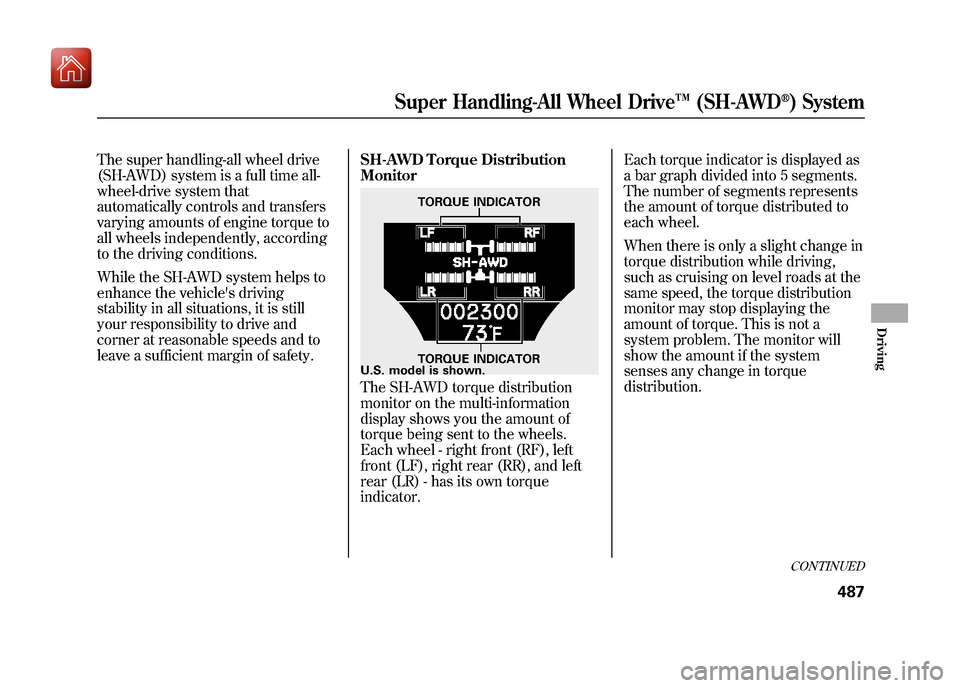
The super handling-all wheel drive
(SH-AWD) system is a full time all-
wheel-drive system that
automatically controls and transfers
varying amounts of engine torque to
all wheels independently, according
to the driving conditions.
While the SH-AWD system helps to
enhance the vehicle's driving
stability in all situations, it is still
your responsibility to drive and
corner at reasonable speeds and to
leave a sufficient margin of safety.SH-AWD Torque Distribution
Monitor
The SH-AWD torque distribution
monitor on the multi-information
display shows you the amount of
torque being sent to the wheels.
Each wheel - right front (RF), left
front (LF), right rear (RR), and left
rear (LR) - has its own torque
indicator.Each torque indicator is displayed as
a bar graph divided into 5 segments.
The number of segments represents
the amount of torque distributed to
each wheel.
When there is only a slight change in
torque distribution while driving,
such as cruising on level roads at the
same speed, the torque distribution
monitor may stop displaying the
amount of torque. This is not a
system problem. The monitor will
show the amount if the system
senses any change in torque
distribution.
TORQUE INDICATOR
TORQUE INDICATOR
U.S. model is shown.
CONTINUED
Super Handling-All Wheel Drive ™(SH-AWD
®) System
487
Driving
09/10/28 17:15:37 10 ACURA ZDX KA KC New North America Own 50 31SZN600 enu
Page 493 of 645

If the SH-AWD indicator blinks while
driving, it indicates the differential
temperature is too high. You will also
see an‘‘SH-AWD DIFF TEMP.
HIGH ’’message on the multi-
information display. If this happens,
pull to the side of the road when it is
safe, shift to Park, and let the engine
idle until the indicator goes out. If
the indicator does not go out, take
your vehicle to a dealer to have it
checked.
If the SH-AWD indicator on the
instrument panel stays on, and the
‘‘ CHECK SH-AWD SYSTEM ’’
message also appears on the multi-
information display, there is problem
with the SH-AWD system. Your vehicle still has normal front-
wheel drive with vehicle stability
assist (VSA), but does not have the
advantages of SH-AWD. Have your
vehicle checked by a dealer as soon
as possible.
Super Handling-All Wheel Drive
™(SH-AWD
®) System
48809/10/28 17:15:37 10 ACURA ZDX KA KC New North America Own 50 31SZN600 enu
Page 495 of 645
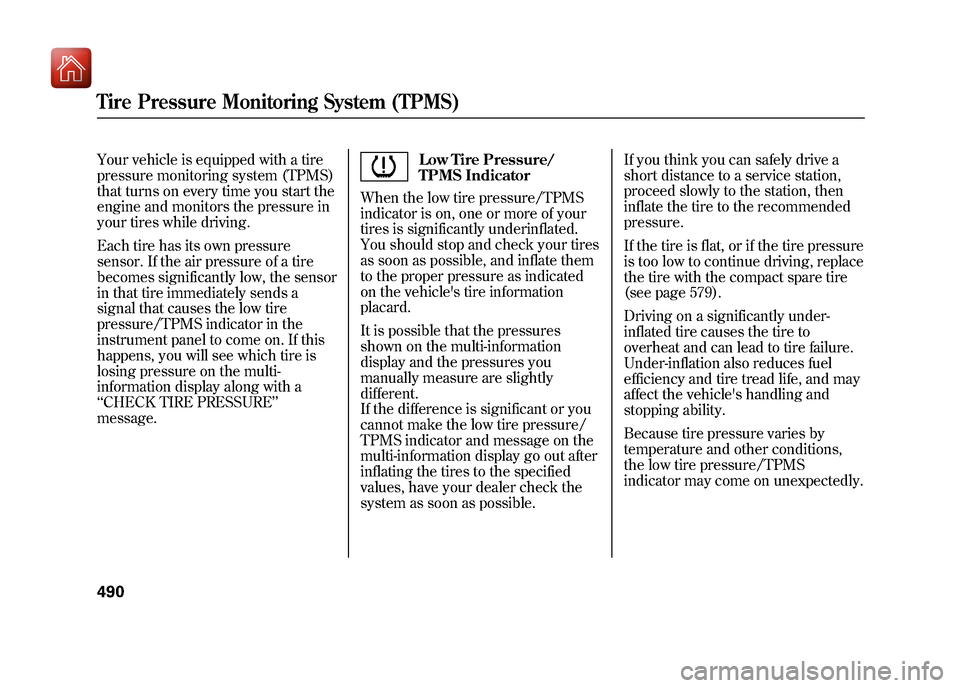
Your vehicle is equipped with a tire
pressure monitoring system (TPMS)
that turns on every time you start the
engine and monitors the pressure in
your tires while driving.
Each tire has its own pressure
sensor. If the air pressure of a tire
becomes significantly low, the sensor
in that tire immediately sends a
signal that causes the low tire
pressure/TPMS indicator in the
instrument panel to come on. If this
happens, you will see which tire is
losing pressure on the multi-
information display along with a
‘‘CHECK TIRE PRESSURE ’’
message.
Low Tire Pressure/
TPMS Indicator
When the low tire pressure/TPMS
indicator is on, one or more of your
tires is significantly underinflated.
You should stop and check your tires
as soon as possible, and inflate them
to the proper pressure as indicated
on the vehicle's tire information
placard.
It is possible that the pressures
shown on the multi-information
display and the pressures you
manually measure are slightly
different.
If the difference is significant or you
cannot make the low tire pressure/
TPMS indicator and message on the
multi-information display go out after
inflating the tires to the specified
values, have your dealer check the
system as soon as possible. If you think you can safely drive a
short distance to a service station,
proceed slowly to the station, then
inflate the tire to the recommended
pressure.
If the tire is flat, or if the tire pressure
is too low to continue driving, replace
the tire with the compact spare tire
(see page 579).
Driving on a significantly under-
inflated tire causes the tire to
overheat and can lead to tire failure.
Under-inflation also reduces fuel
efficiency and tire tread life, and may
affect the vehicle's handling and
stopping ability.
Because tire pressure varies by
temperature and other conditions,
the low tire pressure/TPMS
indicator may come on unexpectedly.
Tire Pressure Monitoring System (TPMS)49009/10/28 17:15:37 10 ACURA ZDX KA KC New North America Own 50 31SZN600 enu